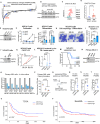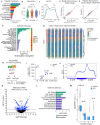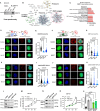Translation efficiency driven by CNOT3 subunit of the CCR4-NOT complex promotes leukemogenesis
- PMID: 38491013
- PMCID: PMC10943099
- DOI: 10.1038/s41467-024-46665-2
Translation efficiency driven by CNOT3 subunit of the CCR4-NOT complex promotes leukemogenesis
Erratum in
-
Publisher Correction: Translation efficiency driven by CNOT3 subunit of the CCR4-NOT complex promotes leukemogenesis.Nat Commun. 2024 Oct 7;15(1):8674. doi: 10.1038/s41467-024-53071-1. Nat Commun. 2024. PMID: 39375334 Free PMC article. No abstract available.
Abstract
Protein synthesis is frequently deregulated during tumorigenesis. However, the precise contexts of selective translational control and the regulators of such mechanisms in cancer is poorly understood. Here, we uncovered CNOT3, a subunit of the CCR4-NOT complex, as an essential modulator of translation in myeloid leukemia. Elevated CNOT3 expression correlates with unfavorable outcomes in patients with acute myeloid leukemia (AML). CNOT3 depletion induces differentiation and apoptosis and delayed leukemogenesis. Transcriptomic and proteomic profiling uncovers c-MYC as a critical downstream target which is translationally regulated by CNOT3. Global analysis of mRNA features demonstrates that CNOT3 selectively influences expression of target genes in a codon usage dependent manner. Furthermore, CNOT3 associates with the protein network largely consisting of ribosomal proteins and translation elongation factors in leukemia cells. Overall, our work elicits the direct requirement for translation efficiency in tumorigenesis and propose targeting the post-transcriptional circuitry via CNOT3 as a therapeutic vulnerability in AML.
© 2024. The Author(s).
Conflict of interest statement
The authors declare no competing interest.
Figures







Similar articles
-
CNOT3 targets negative cell cycle regulators in non-small cell lung cancer development.Oncogene. 2019 Apr;38(14):2580-2594. doi: 10.1038/s41388-018-0603-7. Epub 2018 Dec 10. Oncogene. 2019. PMID: 30531840
-
CNOT3 contributes to cisplatin resistance in lung cancer through inhibiting RIPK3 expression.Apoptosis. 2019 Aug;24(7-8):673-685. doi: 10.1007/s10495-019-01550-y. Apoptosis. 2019. PMID: 31177396
-
Involvement of CNOT3 in mitotic progression through inhibition of MAD1 expression.Biochem Biophys Res Commun. 2012 Mar 9;419(2):268-73. doi: 10.1016/j.bbrc.2012.02.007. Epub 2012 Feb 10. Biochem Biophys Res Commun. 2012. PMID: 22342980
-
Common themes in the pathogenesis of acute myeloid leukemia.Oncogene. 2001 Sep 10;20(40):5680-94. doi: 10.1038/sj.onc.1204642. Oncogene. 2001. PMID: 11607818 Review.
-
Differentiation primary response genes and proto-oncogenes as positive and negative regulators of terminal hematopoietic cell differentiation.Stem Cells. 1994 Jul;12(4):352-69. doi: 10.1002/stem.5530120402. Stem Cells. 1994. PMID: 7951003 Review.
Cited by
-
Revealing the hidden RBP-RNA interactions with RNA modification enzyme-based strategies.Wiley Interdiscip Rev RNA. 2024 May-Jun;15(3):e1863. doi: 10.1002/wrna.1863. Wiley Interdiscip Rev RNA. 2024. PMID: 39392204 Free PMC article. Review.
-
Uridine as a hub in cancer metabolism and RNA biology.Exp Mol Med. 2025 Aug 14. doi: 10.1038/s12276-025-01402-7. Online ahead of print. Exp Mol Med. 2025. PMID: 40804482 Review.
-
Nanopore direct RNA sequencing of human transcriptomes reveals the complexity of mRNA modifications and crosstalk between regulatory features.Cell Genom. 2025 Jun 11;5(6):100872. doi: 10.1016/j.xgen.2025.100872. Epub 2025 May 12. Cell Genom. 2025. PMID: 40359935 Free PMC article.
References
-
- Hanahan, D. Hallmarks of cancer: new dimensions. Cancer Discov.12, 31–46 (2022). - PubMed
-
- Lindsley, R. C. & Ebert, B. L. The biology and clinical impact of genetic lesions in myeloid malignancies. Blood122, 3741–3748 (2013). - PubMed
-
- Jin, Z., MacPherson, K., Liu, Z. & Vu, L. P. RNA modifications in hematological malignancies. Int. J. Hematol.117, 807–820 (2023). - PubMed
MeSH terms
Substances
Grants and funding
LinkOut - more resources
Full Text Sources
Medical
Molecular Biology Databases

